Chinese Electric Power Development Coordination Analysis on Resource, Production and Consumption: A Provincial Case Study
Abstract
:1. Introduction
2. Literature Reviews
3. Research Process
4. Development Index Selection of Electric Power Industry
4.1. Electric Power Industry Structure Construction
4.2. Influencing Factors Selection on Power Industrial Sides
5. The Utilization of Projection Pursuit Model and Coupling Coordination Model
5.1. Projection Pursuit Model
5.2. Coupling Coordination Model
6. Empirical Analysis
6.1. Data Collection
6.2. Projection Pursuit Analysis
6.3. Coupling Coordination Analysis
6.3.1. Coupling Degree
6.3.2. Coordination Degree
6.3.3. Relative Development Degree
7. Discussions
7.1. Technical Support on Electric Power Resource Side
7.2. Project Approval and Supervision on Electric Power Production Side
7.3. Demand Side Management (DSM) on Electric Power Consumption Side
8. Conclusions
Acknowledgments
Author Contributions
Conflicts of Interest
References
- Department of Energy Statistics, National Bureau of Statistics of China. Generating Equipments’ Average Availability Hours of Different Energies (>6 MW) in 2015. Available online: http://www.gov.cn/xinwen/2016-01/29/content_5037241.htm (accessed on 29 January 2016).
- China Electricity Council. China’s Average Utilization Hours of Power Generation Equipments (>6 MW) Have Dropped to 3696. Available online: http://www.askci.com/news/chanye/2016/02/01/94221ojn5.shtml (accessed on 1 February 2016).
- China Renewable Energy Engineering Institute. Statistical Report of Chinese Wind Power Construction in 2015. Available online: http://news.bjx.com.cn/html/20160429/729523.shtml (accessed on 29 April 2016).
- China Photovoltaic Industry Association. China’s Photovoltaic Industry Development Analysis in 2015. Available online: http://mt.sohu.com/20160122/n435468897.shtml (accessed on 22 January 2016).
- BP Amoco. BP Statistical Review of World Energy 2015. Available online: http://www.bp.com/content/dam/bp/pdf/Energy-economics/statistical-review-2015/bp-statistical-review-of-world-energy-2015-full-report.pdf (accessed on 10 June 2015).
- Zhao, Z.; Zuo, J.; Feng, T.; Zillante, G. Impacts of renewable energy regulations on structure of power generation in China—A critical analysis. Renew. Energy 2016, 36, 24–30. [Google Scholar] [CrossRef]
- Zhao, X.; Li, S.; Zhang, S.; Yang, R.; Liu, S. The effectiveness of China’s wind power policy: An empirical analysis. Energy Policy 2016, 95, 269–279. [Google Scholar] [CrossRef]
- Wu, T.; Zhou, W.; Yan, X.; Ou, X. Optimal policy design for photovoltaic power industry with positive externality in China. Resources. Conserv. Recycl. 2016, 115, 22–30. [Google Scholar] [CrossRef]
- Zeng, M.; Yang, Y.; Wang, L.; Sun, J. The power industry reform in China 2015: Policies, evaluations and solutions. Renew. Sustain. Energy Rev. 2016, 57, 94–110. [Google Scholar] [CrossRef]
- Zhao, G.; Guerrero, J.M.; Pei, Y. Marginal generation technology in the Chinese power market towards 2030 based on consequential life cycle assessment. Energies 2016, 9, 788. [Google Scholar] [CrossRef]
- Guo, X.; Zhu, Q.; Lv, L.; Chu, J.; Wu, J. Efficiency evaluation of regional energy saving and emission reduction in China: A modified slacks-based measure approach. J. Clean. Prod. 2017, 140, 1313–1321. [Google Scholar] [CrossRef]
- Li, H.; Li, G.; Wu, Y.; Wang, Z.; Wang, J. Operation modeling of power systems integrated with large-scale new energy sources. Energies 2016, 9, 810. [Google Scholar] [CrossRef]
- Tao, X.; Wang, P.; Zhu, B. Measuring the interprovincial CO2 emissions considering electric power dispatching in China: From production and consumption perspectives. Sustainability 2016, 8, 506. [Google Scholar] [CrossRef]
- Sun, W.; Xu, Y. Research on China’s Energy Supply and Demand Using an Improved Grey-Markov Chain Model Based on Wavelet Transform. Available online: http://ac.els-cdn.com/S0360544216315663/1-s2.0-S0360544216315663-main.pdf?_tid=b24f6456-cf31-11e6-8884-00000aab0f02&acdnat=1483172483_7e1e609037949683123e83a131c57de5 (accessed on 11 November 2016).
- De Castro Camioto, F.; Moralles, H.F.; Mariano, E.B.; do Nascimento Rebelatto, D.A. Energy efficiency analysis of G7 and BRICS considering total-factor structure. J. Clean. Prod. 2016, 122, 67–77. [Google Scholar] [CrossRef]
- Yu, X.; Moreno-Cruz, J.; Crittenden, J.C. Regional energy rebound effect: The impact of economy-wide and sector level energy efficiency improvement in Georgia, USA. Energy Policy 2015, 87, 250–259. [Google Scholar] [CrossRef]
- Suzuki, S.; Nijkamp, P. An evaluation of energy-environment-economic efficiency for EU, APEC and ASEAN countries: Design of a Target-Oriented DFM model with fixed factors in Data Envelopment Analysis. Energy Policy 2016, 88, 100–112. [Google Scholar] [CrossRef]
- Huang, Y.; Bor, Y.J.; Peng, C.-Y. The long-term forecast of Taiwan’s energy supply and demand: LEAP model application. Energy Policy 2011, 39, 6790–6803. [Google Scholar] [CrossRef]
- Cosmi, C.; Dvarionienë, J.; Marques, I.; Di Leo, S.; Gecevičius, G.; Gurauskienė, I.; Mendes, G.; Selada, C. A holistic approach to sustainable energy development at regional level: The RENERGY self-assessment methodology. Renew. Sustain. Energy Rev. 2015, 49, 693–707. [Google Scholar] [CrossRef]
- Mauky, E.; Fabian Jacobi, H.; Liebetrau, J.; Nelles, M. Flexible biogas production for demand-driven energy supply—Feeding strategies and types of substrates. Bioresource Technol. 2015, 178, 262–269. [Google Scholar] [CrossRef] [PubMed]
- Wang, R.; Wang, P.; Xiao, G.; Gong, S. Power demand and supply management in microgrids with uncertainties of renewable energies. Int. J. Electr. Power Energy Syst. 2014, 63, 260–269. [Google Scholar] [CrossRef]
- Liu, F.; Lv, T.; Sajid, M.; Li, X. Optimization for China’s coal flow based on matching supply and demand sides. Resour. Conserv. Recycl. 2016, in press. [Google Scholar] [CrossRef]
- Spalding-Fecher, R.; Senatla, M.; Yamba, F.; Lukwesa, B.; Himunzowa, G.; Heaps, C.; Chapman, A.; Mahumane, G.; Tembo, B.; Nyambe, I. Electricity supply and demand scenarios for the Southern African power pool. Energy Policy 2016, in press. [Google Scholar] [CrossRef]
- Quiggin, D.; Buswell, R. The implications of heat electrification on national electrical supply-demand balance under published 2050 energy scenarios. Energy 2016, 98, 253–270. [Google Scholar] [CrossRef]
- Zha, Y.; Zhao, L.; Bian, Y. Measuring regional efficiency of energy and carbon dioxide emissions in China: A chance constrained DEA approach. Comput. Oper. Res. 2016, 66, 351–361. [Google Scholar] [CrossRef]
- Viholainena, J.; Luoranenb, M.; Väisänenb, S.; Nikkanen, A.; Horttanainen, M.; Soukka, R. Regional level approach for increasing energy efficiency. Appl. Energy 2016, 163, 295–303. [Google Scholar] [CrossRef]
- Peng, L.; Zhang, Y.; Wang, Y.; Zeng, X.; Peng, N.; Yu, A. Energy efficiency and influencing factor analysis in the overall Chinese textile industry. Energy 2015, 93, 1222–1229. [Google Scholar] [CrossRef]
- Özkara, Y.; Atak, M. Regional total-factor energy efficiency and electricity saving potential of manufacturing industry in Turkey. Energy 2015, 93, 495–510. [Google Scholar] [CrossRef]
- Akritas, M.G. Projection pursuit multi-index (PPMI) models. Stat. Probab. Lett. 2016, 114, 99–103. [Google Scholar] [CrossRef]
- Xia, C.; Li, Y.; Ye, Y.; Shi, Z. An integrated approach to explore the relationship among economic, construction land use, and ecology subsystems in Zhejiang Province, China. Sustainability 2016, 8, 498. [Google Scholar] [CrossRef]
- Wu, Y.; Zhang, W. The driving factors behind coal demand in China from 1997 to 2012: An empirical study of input-output structural decomposition analysis. Energy Policy 2016, 95, 126–134. [Google Scholar] [CrossRef]
- National Bureau of Statistic of the People’s Republic of China. The National Economic and Social Development Statistical Bulletin in 2014; China Statistics Press: Beijing, China, 2015.
- Friedman, J.H.; Stuetzle, W. Projection Pursuit Methods for Data Analysis; Academic Press: London, UK, 1982; pp. 123–147. [Google Scholar]
- Zhang, C.; Dong, S. A new water quality assessment model based on projection pursuit technique. J. Environ. Sci. 2009, 21, 154–157. [Google Scholar] [CrossRef]
- Shao, X.H.; Hou, M.M.; Chen, L.H.; Chang, T.T.; Wang, W.N. Evaluation of subsurface drainage design based on projection pursuit. Energy Procedia 2012, 16 Pt B, 747–752. [Google Scholar] [CrossRef]
- Xiao, F.; Chen, J. Fractal projection pursuit classification model applied to geochemical survey data. Comput. Geosci. 2012, 45, 75–81. [Google Scholar] [CrossRef]
- Tang, Z. An integrated approach to evaluating the coupling coordination between tourism and the environment. Tour. Manag. 2015, 46, 11–19. [Google Scholar] [CrossRef]
- National Bureau of Statistics of the People’s Republic of China. China Energy Statistical Yearbook 2014; China Statistics Press: Beijing, China, 2015.
- Chinese Academy of Social Sciences (CASS). World Energy China Outlook 2014–2015. Available online: http://sky.cssn.cn/gj/gj_qkzz/201505/t20150509_1763714.shtm (accessed on 26 March 2015).
- Cao, X.; Wen, Z.; Chen, J.; Li, H. Contributing to differentiated technology policy-making on the promotion of energy efficiency technologies in heavy industrial sector: A case study of China. J. Clean. Prod. 2016, 112, 1486–1497. [Google Scholar] [CrossRef]
- Li, C.B.; Chen, H.Y.; Zhu, J.; Zuo, J.; Zillante, G.; Zhao, Z.Y. Comprehensive assessment of flexibility of wind power industry chain. Renew. Energy 2015, 74, 18–26. [Google Scholar] [CrossRef]
- Vlad, C.; Barbu, M.; Vilanova, R. Intelligence control of a distributed generation system based on renewable sources. Sustainability 2016, 8, 748. [Google Scholar] [CrossRef]
- Zhao, Z.; Zhu, J.; Zuo, J. Flexibility of wind power industry chain for environmental turbulence: A matching model study. Renew. Energy 2015, 83, 375–397. [Google Scholar] [CrossRef]
- The State Council. National Science and Technology Innovation Plan during the 13th Five-Year Period. Available online: http://www.gov.cn/zhengce/content/2016-08/08/ content_5098072.htm (accessed on 8 August 2016).
- General Office of the State Council (GOSC). Energy Development Strategy Action Plan 2014–2020. Available online: http://www.gov.cn/zhengce/content/2014-11/19/content_9222.htm (accessed on 19 November 2014).
- National Energy Administration (NEA). Key Points of Market Supervision in 2016. Available online: http://www.nea.gov.cn/2016-04/08/c_135261215.htm (accessed on 8 April 2016).
- Thakur, J.; Chakraborty, B. Demand side management in developing nations: A mitigating tool for energy imbalance and peak load management. Energy 2016, 114, 895–912. [Google Scholar] [CrossRef]
- Zhao, Z.; Zhu, J.; Zuo, J. Sustainable development of the wind power industry in a complex environment: A flexibility study. Energy Policy 2014, 75, 392–397. [Google Scholar] [CrossRef]
- Hippert, H.S.; Pedreira, C.E.; Souza, R.C. Neural networks for short-term load forecasting: A review and evaluation. IEEE Trans. Power Syst. 2001, 16, 44–55. [Google Scholar] [CrossRef]
- Tepedino, C.; Guarnaccia, C.; Iliev, S.; Popova, S.B.; Quartieri, J. A forecasting model based on time series analysis applied to electrical energy consumption. Int. J. Math. Models Methods Appl. Sci. 2015, 9, 432–445. [Google Scholar]
- Liu, J.; Wang, L.; Qiu, M.; Zhu, J. Promotion potentiality and optimal strategies analysis of provincial energy efficiency in China. Sustainability 2016, 8, 741. [Google Scholar] [CrossRef]
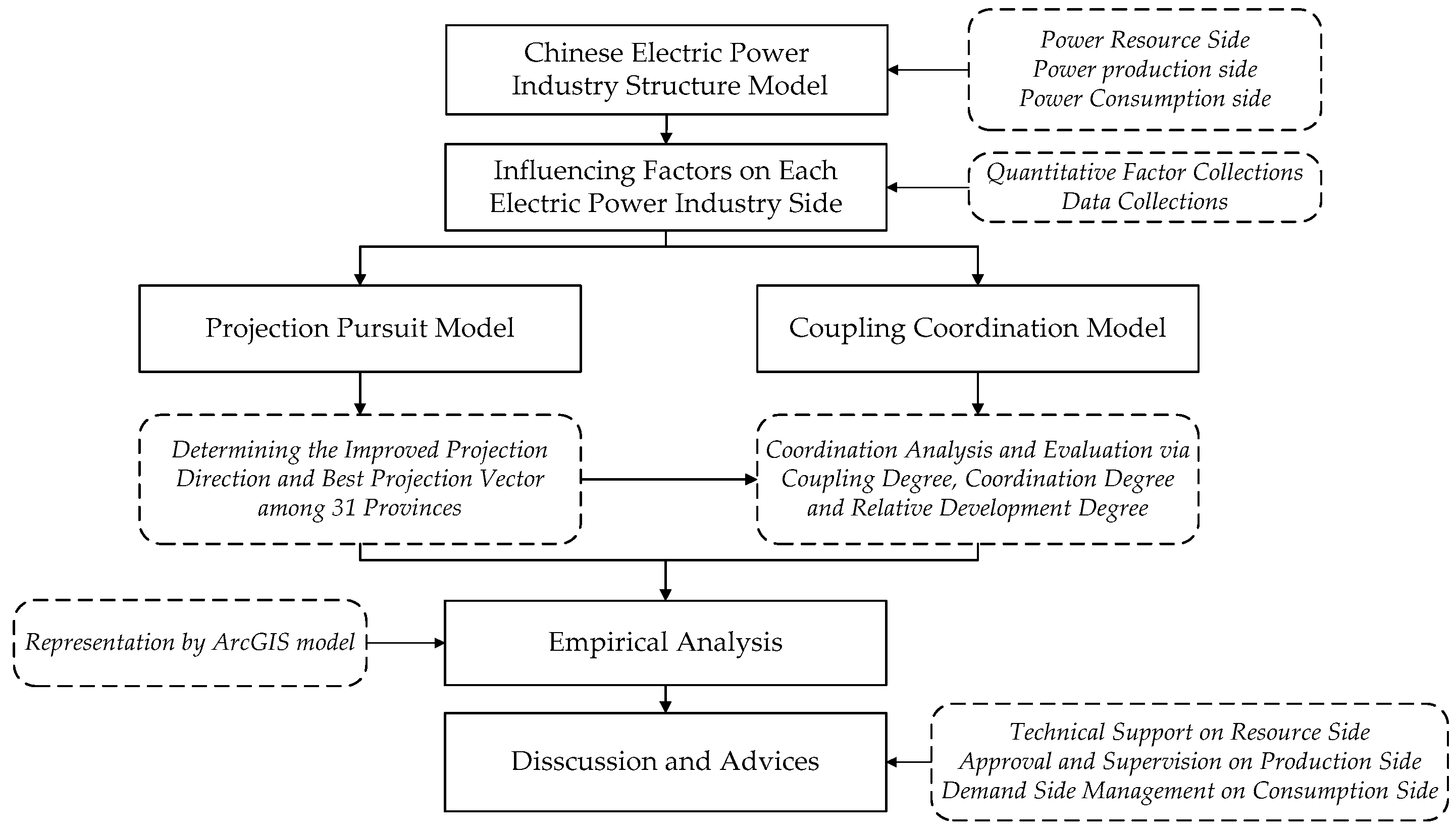
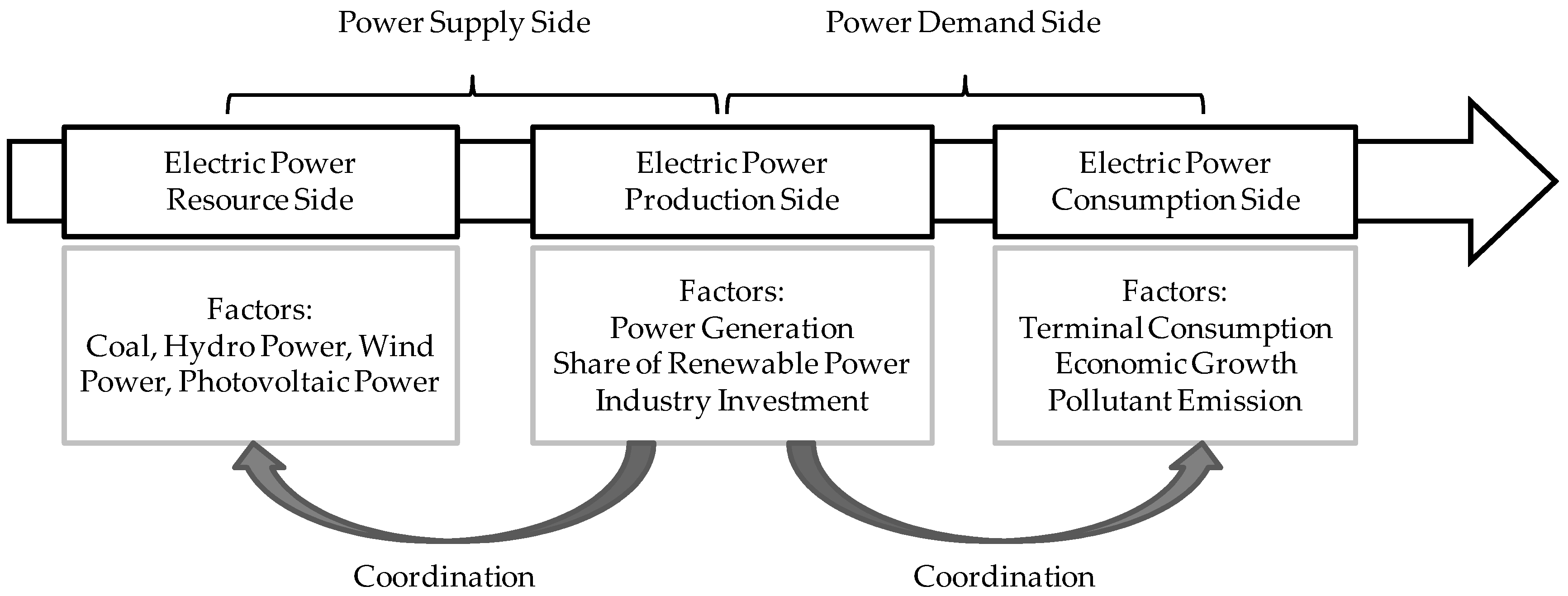
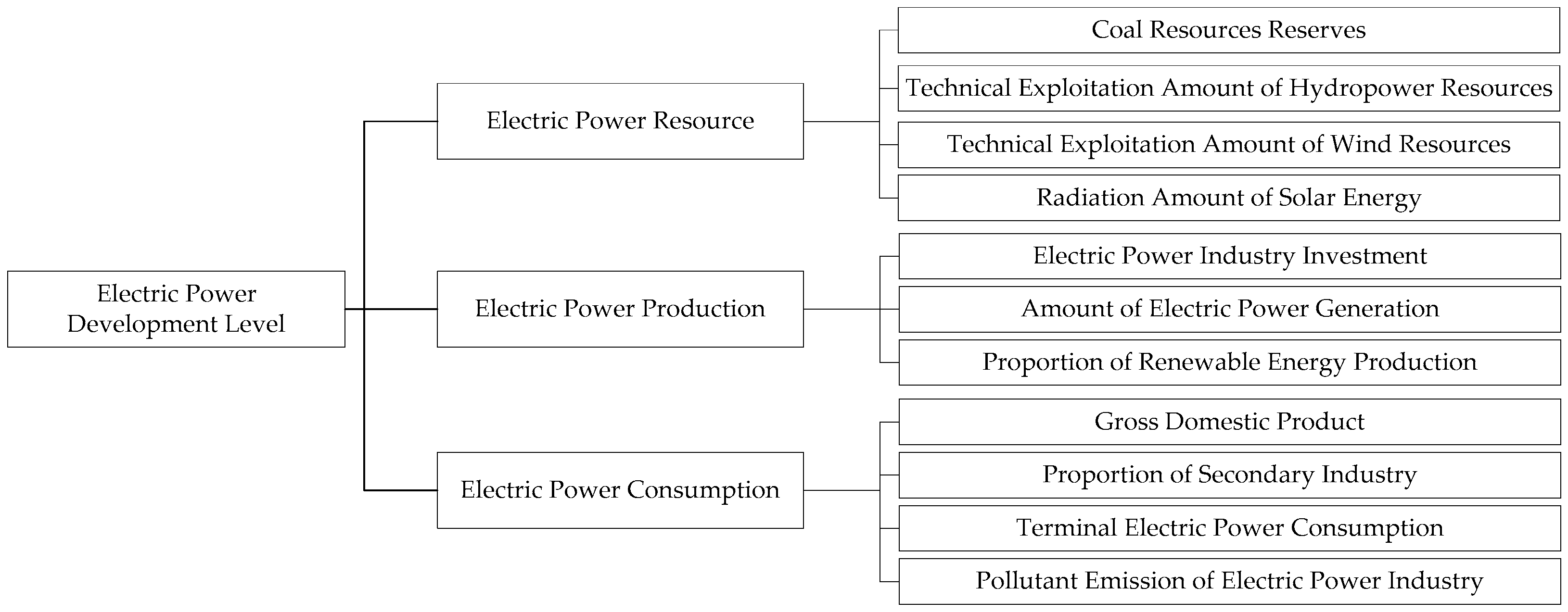


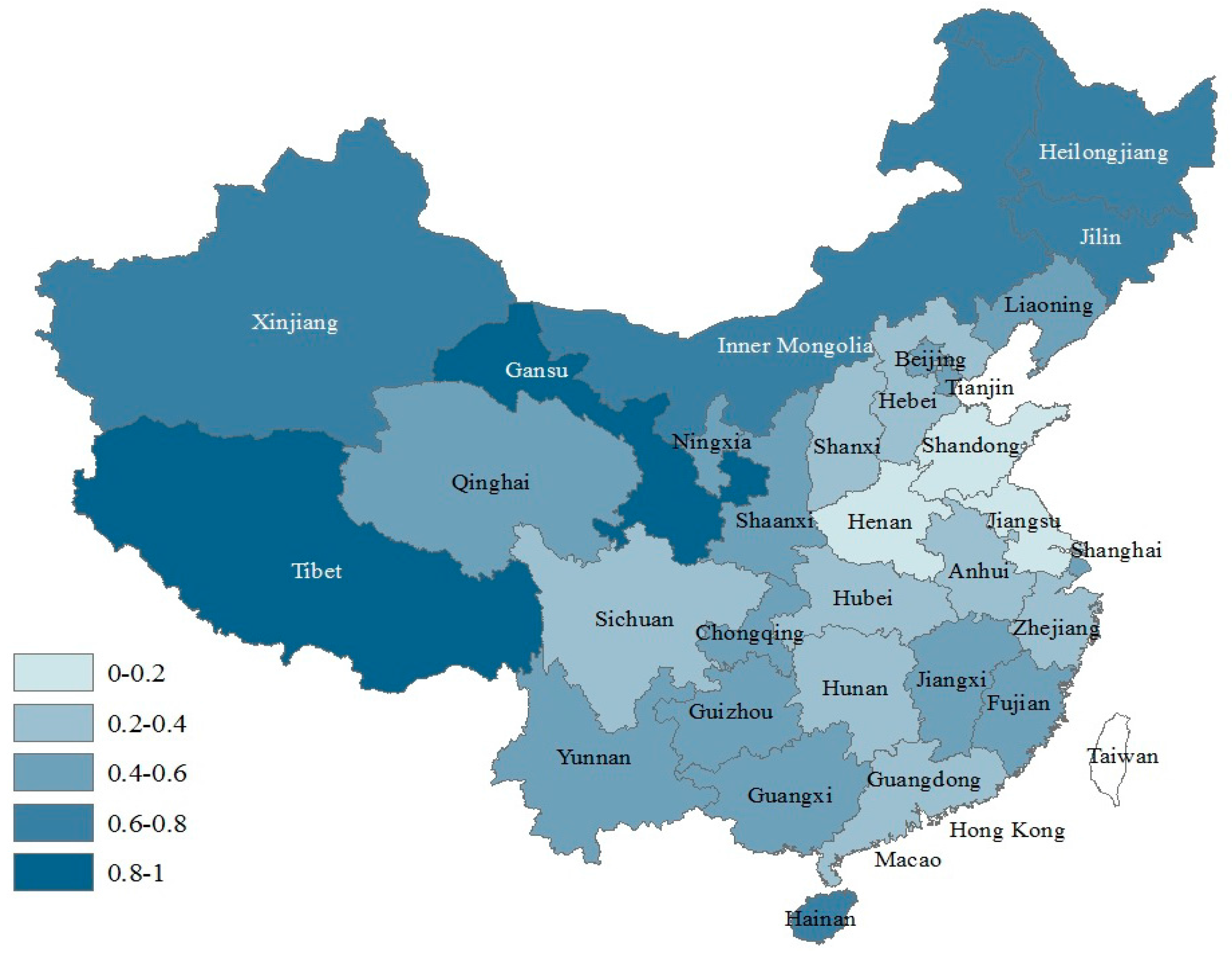
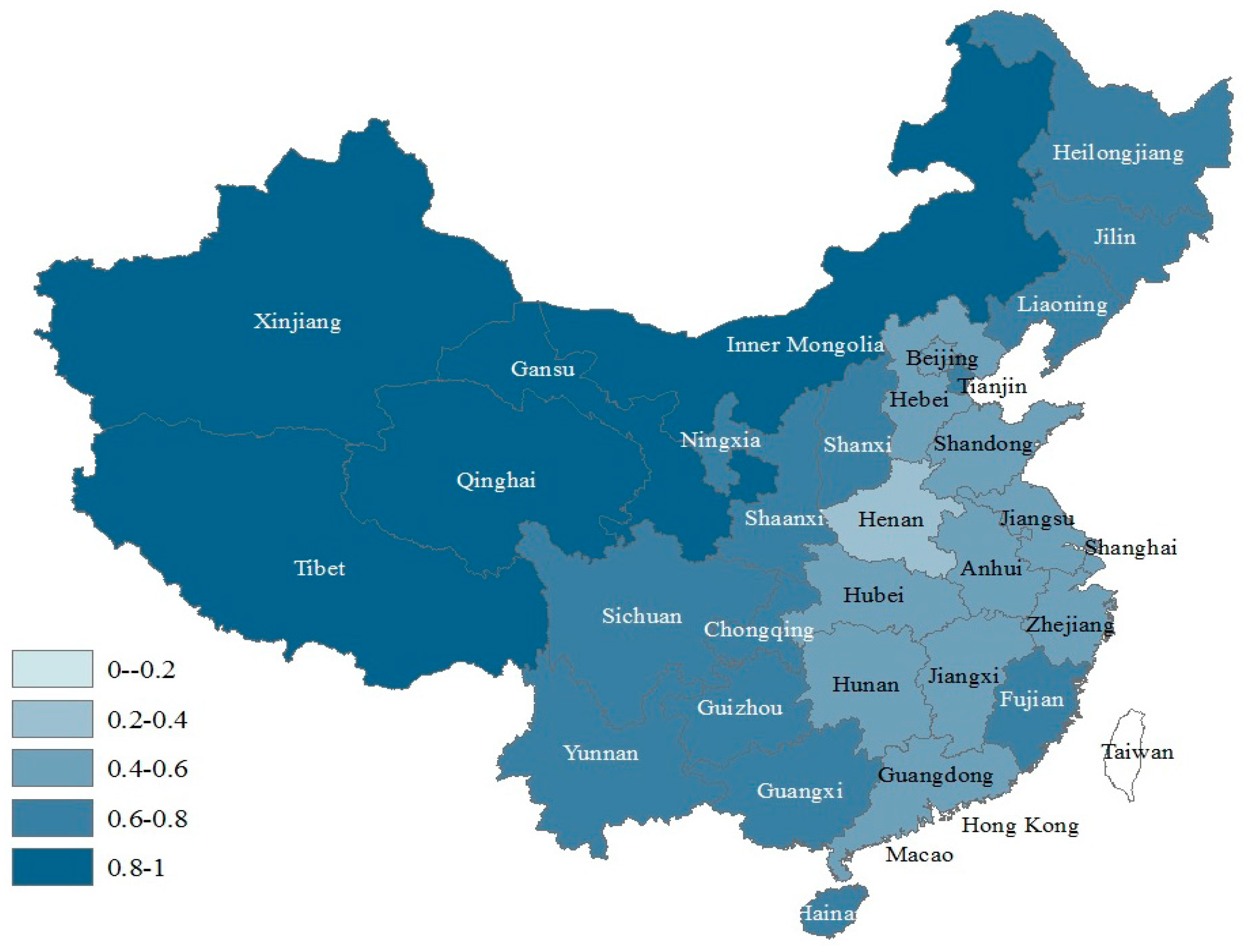

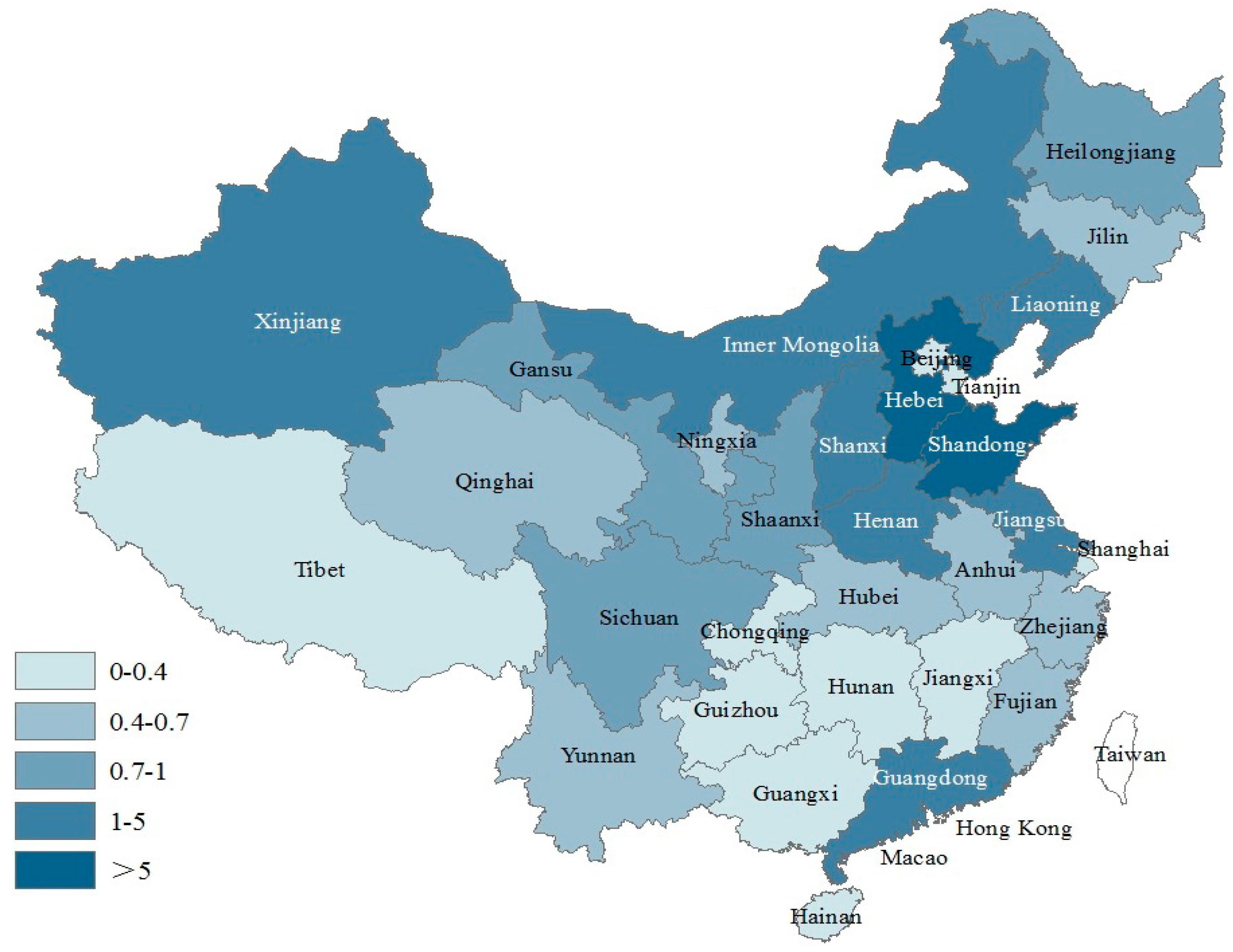
| Side | Variable | Factor | |
|---|---|---|---|
| Electric power resource | R | ri1 | Coal resources reserves (million ton) |
| ri2 | Technical exploitation amount of hydropower resources (thousand kW) | ||
| ri3 | Technical exploitation amount of wind resources (thousand kW) | ||
| ri4 | Radiation amount of solar energy (kW/m2·a) | ||
| Electric power production | P | pi1 | Electric power industry investment (million Yuan) |
| pi2 | Amount of electric power generation (million kWh) | ||
| pi3 | Proportion of renewable energy production (%) | ||
| Electric power consumption | C | ci1 | Gross domestic product (million Yuan) |
| ci2 | Proportion of secondary industry (%) | ||
| ci3 | Terminal electric power consumption (thousand tce) | ||
| ci4 | Pollutant emission of electric power industry (thousand ton) | ||
| Index | ri1 | ri2 | ri3 | ri4 | pi1 | pi2 | pi3 | ci1 | ci2 | ci3 | ci4 | ||||||||
|---|---|---|---|---|---|---|---|---|---|---|---|---|---|---|---|---|---|---|---|
| Province | 2011 | 2014 | 2011 | 2014 | 2011 | 2014 | 2011 | 2014 | 2011 | 2014 | 2011 | 2014 | 2011 | 2014 | |||||
| Beijing | 376 | 1320 | 500 | 1560 | 14,100 | 23,000 | 26,600 | 36,900 | 1.32 | 0.81 | 1,625,193 | 2,133,083 | 23.1 | 21.3 | 69,540 | 67,240 | 198 | 174 | |
| Tianjin | 297 | 1530 | 560 | 1600 | 43,100 | 59,100 | 61,300 | 61,200 | 0.23 | 1.11 | 1,130,728 | 1,572,693 | 52.4 | 49.2 | 68,180 | 78,820 | 340 | 288 | |
| Hebei | 3841 | 1830 | 41,880 | 1550 | 96,300 | 120,200 | 225,000 | 238,300 | 4.00 | 7.13 | 2,451,576 | 2,942,115 | 53.5 | 51.0 | 275,310 | 296,640 | 1713 | 1475 | |
| Shanxi | 83,459 | 3520 | 15,980 | 1600 | 191,900 | 209,800 | 234,400 | 264,300 | 0.55 | 2.99 | 1,123,755 | 1,276,149 | 59.0 | 49.3 | 168,080 | 197,610 | 1241 | 1069 | |
| Inner Mongolia | 36,889 | 1070 | 1,459,670 | 1870 | 190,300 | 233,100 | 313,500 | 386,100 | 7.27 | 10.64 | 1,435,988 | 1,777,019 | 56.0 | 51.3 | 168,200 | 176,810 | 1314 | 1238 | |
| Liaoning | 3097 | 1890 | 59,810 | 1400 | 96,000 | 109,400 | 142,300 | 161,700 | 4.64 | 6.43 | 2,222,670 | 2,862,658 | 54.7 | 50.2 | 209,470 | 217,210 | 1020 | 880 | |
| Jilin | 952 | 4330 | 62,840 | 1300 | 61,600 | 66,300 | 70,500 | 75,800 | 5.67 | 7.65 | 1,056,883 | 1,380,314 | 53.1 | 52.8 | 82,970 | 86,450 | 582 | 542 | |
| Heilongjiang | 6175 | 1050 | 96,510 | 1393 | 98,300 | 99,100 | 83,400 | 89,400 | 5.28 | 8.05 | 1,258,200 | 1,503,938 | 50.3 | 36.9 | 112,340 | 118,530 | 753 | 730 | |
| Shanghai | 0 | 450 | 510 | 1290 | 14,500 | 14,300 | 102,600 | 80,800 | 0.39 | 0.99 | 1,919,569 | 2,356,770 | 41.3 | 34.7 | 112,010 | 113,460 | 443 | 365 | |
| Jiangsu | 1081 | 1760 | 3700 | 1240 | 59,800 | 90,800 | 393,300 | 434,800 | 0.71 | 1.61 | 4,911,027 | 6,508,832 | 51.3 | 47.4 | 257,740 | 292,050 | 1472 | 1214 | |
| Zhejiang | 44 | 10,340 | 2090 | 1350 | 52,900 | 75,600 | 279,000 | 291,300 | 0.22 | 0.55 | 3,231,885 | 4,017,303 | 51.2 | 47.7 | 168,650 | 186,400 | 853 | 699 | |
| Anhui | 7991 | 3420 | 770 | 1310 | 48,100 | 60,600 | 165,500 | 202,800 | 0.18 | 0.74 | 1,530,065 | 2,084,875 | 54.3 | 53.1 | 97,070 | 116,960 | 909 | 820 | |
| Fujian | 429 | 15,250 | 9550 | 1300 | 63,000 | 87,700 | 157,900 | 187,000 | 1.39 | 2.03 | 1,756,018 | 2,405,576 | 51.6 | 52.0 | 98,090 | 111,900 | 448 | 409 | |
| Jiangxi | 426 | 5070 | 3100 | 1200 | 33,100 | 35,000 | 74,200 | 87,600 | 0.30 | 0.68 | 1,170,282 | 1,571,463 | 54.6 | 52.5 | 63,550 | 75,830 | 582 | 542 | |
| Shandong | 7410 | 4270 | 30,180 | 1450 | 113,300 | 155,900 | 317,200 | 373,800 | 1.32 | 2.82 | 4,536,185 | 5,942,659 | 52.9 | 48.4 | 348,080 | 353,380 | 1740 | 1460 | |
| Henan | 9746 | 4950 | 3890 | 1400 | 82,700 | 86,800 | 259,800 | 267,500 | 0.07 | 0.30 | 2,693,103 | 3,493,824 | 57.3 | 51.0 | 214,380 | 219,090 | 1590 | 1356 | |
| Hubei | 325 | 63,500 | 1260 | 1230 | 51,800 | 51,100 | 210,200 | 239,500 | 0.07 | 0.54 | 1,963,226 | 2,737,922 | 50.0 | 46.9 | 151,380 | 157,030 | 631 | 586 | |
| Hunan | 1329 | 23,330 | 1130 | 1130 | 60,100 | 67,700 | 120,400 | 126,100 | 0.04 | 0.63 | 1,966,956 | 2,703,722 | 47.6 | 46.2 | 148,800 | 149,190 | 604 | 550 | |
| Guangdong | 23 | 22,950 | 13,670 | 1250 | 89,100 | 114,700 | 369,600 | 380,500 | 0.43 | 0.89 | 5,321,028 | 6,780,985 | 49.7 | 46.3 | 269,080 | 284,800 | 1323 | 1099 | |
| Guangxi | 202 | 19,430 | 6920 | 1380 | 42,100 | 56,000 | 105,200 | 129,800 | 0.01 | 0.23 | 1,172,087 | 1,567,289 | 48.4 | 46.7 | 79,190 | 91,000 | 451 | 411 | |
| Hainan | 119 | 1240 | 2060 | 1400 | 10,100 | 12,700 | 18,900 | 24,600 | 2.80 | 2.44 | 252,266 | 350,072 | 28.3 | 25.0 | 13,590 | 17,200 | 80 | 98 | |
| Chongqing | 1857 | 7980 | 1380 | 1300 | 34,300 | 57,500 | 53,400 | 67,400 | 0.19 | 0.30 | 1,001,137 | 1,426,260 | 55.4 | 45.8 | 78,560 | 80,490 | 382 | 356 | |
| Sichuan | 5182 | 52,880 | 3400 | 1230 | 131,500 | 142,900 | 185,700 | 313,000 | 0.01 | 0.16 | 2,102,668 | 2,853,666 | 52.5 | 48.9 | 178,920 | 192,120 | 620 | 577 | |
| Guizhou | 5874 | 17,020 | 4560 | 928 | 70,400 | 58,600 | 141,600 | 184,500 | 0.07 | 0.98 | 570,184 | 926,639 | 38.5 | 41.6 | 81,750 | 92,990 | 493 | 445 | |
| Yunnan | 5967 | 38,470 | 20,660 | 1200 | 89,100 | 118,400 | 155,500 | 255,000 | 0.64 | 2.63 | 889,312 | 1,281,459 | 42.5 | 41.2 | 86,740 | 100,720 | 520 | 490 | |
| Tibet | 12 | 53,540 | 650 | 2100 | 6400 | 16,700 | 2300 | 2600 | 5.91 | 11.54 | 60,583 | 92,083 | 34.5 | 36.6 | 3460 | 4300 | 38 | 38 | |
| Shaanxi | 10,759 | 3320 | 11,150 | 1500 | 123,500 | 178,600 | 117,900 | 132,600 | 0.08 | 1.13 | 1,251,230 | 1,768,994 | 55.4 | 54.1 | 88,820 | 106,100 | 766 | 690 | |
| Gansu | 2351 | 7600 | 236,340 | 1900 | 63,800 | 109,400 | 106,800 | 124,100 | 6.74 | 12.41 | 502,037 | 683,682 | 47.4 | 42.8 | 59,230 | 72,870 | 420 | 407 | |
| Qinghai | 1612 | 11,150 | 20,080 | 2200 | 23,200 | 39,700 | 49,000 | 59,600 | 0.20 | 10.40 | 167,044 | 230,332 | 58.4 | 53.6 | 25,680 | 37,680 | 116 | 134 | |
| Ningxia | 3128 | 670 | 15,550 | 1700 | 41,400 | 43,900 | 99,900 | 116,700 | 1.50 | 8.23 | 210,221 | 275,210 | 50.2 | 48.7 | 36,810 | 47,810 | 418 | 398 | |
| Xinjiang | 14,836 | 3510 | 435,550 | 2050 | 123,300 | 210,100 | 87,500 | 209,300 | 3.20 | 8.50 | 661,005 | 927,346 | 48.8 | 42.6 | 82,900 | 136,320 | 588 | 588 | |
| Index | z(R)* | z(P-2011)* | z(C-2011)* | z(P-2014)* | z(C-2014)* | |
|---|---|---|---|---|---|---|
| Province | ||||||
| Beijing | 0.0000 | 0.1845 | 1.2241 | 0.0956 | 1.2260 | |
| Tianjin | 0.0000 | 0.0590 | 1.1764 | 0.2545 | 1.1780 | |
| Hebei | 0.0284 | 0.6175 | 0.1822 | 0.8858 | 0.1503 | |
| Shanxi | 0.0106 | 0.2202 | 0.5797 | 1.0431 | 0.5478 | |
| Inner Mongolia | 1.0000 | 1.1368 | 0.5513 | 1.5601 | 0.5004 | |
| Liaoning | 0.0406 | 0.7021 | 0.6141 | 0.7453 | 0.6091 | |
| Jilin | 0.0427 | 0.8155 | 1.0387 | 0.5661 | 1.0273 | |
| Heilongjiang | 0.0658 | 0.7892 | 0.9108 | 0.7077 | 0.8667 | |
| Shanghai | 0.0000 | 0.0605 | 1.0510 | 0.1161 | 1.0614 | |
| Jiangsu | 0.0022 | 0.1460 | 0.3438 | 0.7463 | 0.3087 | |
| Zhejiang | 0.0011 | 0.0702 | 0.7755 | 0.5108 | 0.7689 | |
| Anhui | 0.0002 | 0.0591 | 0.8679 | 0.3817 | 0.8279 | |
| Fujian | 0.0062 | 0.2353 | 1.0775 | 0.5125 | 1.0498 | |
| Jiangxi | 0.0018 | 0.0611 | 1.0745 | 0.1804 | 1.0490 | |
| Shandong | 0.0203 | 0.2679 | 0.0512 | 0.9591 | 0.0607 | |
| Henan | 0.0023 | 0.0718 | 0.3497 | 0.5154 | 0.3636 | |
| Hubei | 0.0005 | 0.0480 | 0.8989 | 0.3769 | 0.8811 | |
| Hunan | 0.0004 | 0.0479 | 0.9153 | 0.3270 | 0.9158 | |
| Guangdong | 0.0090 | 0.1295 | 0.3942 | 0.7449 | 0.3840 | |
| Guangxi | 0.0044 | 0.0296 | 1.1081 | 0.2739 | 1.0957 | |
| Hainan | 0.0011 | 0.3841 | 1.3747 | 0.1165 | 1.3630 | |
| Chongqing | 0.0006 | 0.0466 | 1.1349 | 0.2211 | 1.1452 | |
| Sichuan | 0.0020 | 0.0993 | 0.8518 | 0.7447 | 0.8144 | |
| Guizhou | 0.0028 | 0.0602 | 1.0723 | 0.3670 | 1.0676 | |
| Yunnan | 0.0138 | 0.1527 | 1.0563 | 0.7079 | 1.0300 | |
| Tibet | 0.0001 | 0.8047 | 1.4157 | 0.4883 | 1.4369 | |
| Shaanxi | 0.0073 | 0.1016 | 0.9447 | 0.7314 | 0.9126 | |
| Gansu | 0.1616 | 0.9636 | 1.1533 | 0.9581 | 1.1274 | |
| Qinghai | 0.0134 | 0.0404 | 1.3443 | 0.5746 | 1.3253 | |
| Ningxia | 0.0103 | 0.2323 | 1.1942 | 0.5535 | 1.1793 | |
| Xinjiang | 0.2981 | 0.5253 | 1.0359 | 1.2207 | 0.9120 | |
© 2017 by the authors. Licensee MDPI, Basel, Switzerland. This article is an open access article distributed under the terms and conditions of the Creative Commons Attribution (CC BY) license ( http://creativecommons.org/licenses/by/4.0/).
Share and Cite
Zhu, J.; Zhao, Z. Chinese Electric Power Development Coordination Analysis on Resource, Production and Consumption: A Provincial Case Study. Sustainability 2017, 9, 209. https://doi.org/10.3390/su9020209
Zhu J, Zhao Z. Chinese Electric Power Development Coordination Analysis on Resource, Production and Consumption: A Provincial Case Study. Sustainability. 2017; 9(2):209. https://doi.org/10.3390/su9020209
Chicago/Turabian StyleZhu, Jiang, and Zhenyu Zhao. 2017. "Chinese Electric Power Development Coordination Analysis on Resource, Production and Consumption: A Provincial Case Study" Sustainability 9, no. 2: 209. https://doi.org/10.3390/su9020209
APA StyleZhu, J., & Zhao, Z. (2017). Chinese Electric Power Development Coordination Analysis on Resource, Production and Consumption: A Provincial Case Study. Sustainability, 9(2), 209. https://doi.org/10.3390/su9020209





